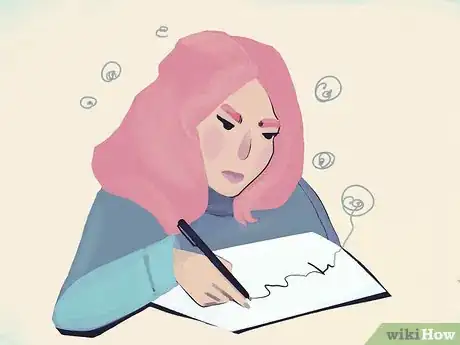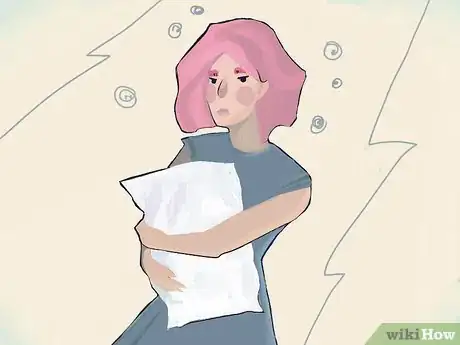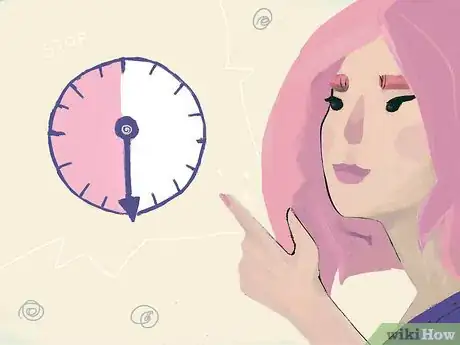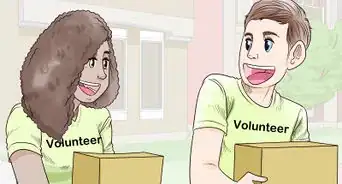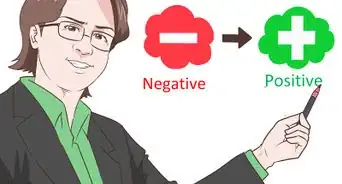This article was co-authored by Rahti Gorfien, PCC. Rahti Gorfien is a Life Coach and the Founder of Creative Calling Coaching, LLC. She specializes in working with artists, entrepreneurs, and college students in creative fields. Rahti is accredited as a Professional Certified Coach (PCC) by the International Coach Federation, an ACCG Accredited ADHD Coach by the ADD Coach Academy, and a Career Specialty Services Provider (CSS). In addition, she has personal experience in the fields she coaches - she is an alumnus of the New York University Graduate Acting program and has been a working theater artist for over 30 years. She was voted one of the 15 Best Life Coaches in New York City by Expertise in 2018.
wikiHow marks an article as reader-approved once it receives enough positive feedback. This article received 39 testimonials and 83% of readers who voted found it helpful, earning it our reader-approved status.
This article has been viewed 1,383,012 times.
You can't get an embarrassing moment or a cute barista off of your mind. These kinds of thoughts are common, but if they're proving to be too distracting, there are steps you can take to rid yourself of unwanted thoughts. Start by putting your full attention on this article.
Steps
Engaging in Thought Stopping
-
1Write your thought(s) down. Your thoughts are distracting you from your daily activities and causing you unhappiness, anxiety or worry, so the first thing you must do is put them on paper. Write down all your upsetting thoughts in order of the most stressful to the least stressful.
- For example, if you keep thinking you might lose your job, your list could look something like this: 1. How will I be able to pay my bills and take care of my child? 2. What if I can't find a new job? 3. I'll be so embarrassed if I'm escorted by security out of the office with my belongings in a box.
- You're going to begin your practice with the least-stressful thought.
-
2Imagine the thought. Sit or lie down in a private place. Close your eyes. Imagine a situation in which you might have this stressful thought.Advertisement
-
3Stop the thought. Set a timer, watch or other alarm for three minutes. Then focus on your unwanted thought. When the timer or alarm goes off, shout "Stop!" That's your cue to empty your mind of that thought. Think of one intentional thought (the beach, etc.) and keep your mind fixed on that image or thought for 30 seconds. If the upsetting thought comes back during that time, shout "Stop!" again. Practicing meditation or yoga may help calm and clear your mind.
- You can stand up when you say "Stop" if you'd like or snap your fingers or clap your hands. These actions reinforce the "Stop" command and further interrupt your thought.
- Instead of using a timer, you can tape-record yourself shouting "Stop!" at one-, two- and three-minute intervals and use the recording to do the thought-stopping exercise. When you hear your recorded voice say "Stop," empty your mind for 30 seconds.
EXPERT TIPChloe Carmichael, PhD is a Licensed Clinical Psychologist who runs a private practice in New York City. With over a decade of psychological consulting experience, Dr. Chloe specializes in relationship issues, stress management, self esteem, and career coaching. She has also instructed undergraduate courses at Long Island University and has served as adjunct faculty at the City University of New York. Dr. Chloe completed her PhD in Clinical Psychology at Long Island University in Brooklyn, New York and her clinical training at Lenox Hill Hospital and Kings County Hospital. She is accredited by the American Psychological Association and is the author of “Nervous Energy: Harness the Power of Your Anxiety” and “Dr. Chloe's 10 Commandments of Dating.”Licensed Clinical Psychologist
 Chloe Carmichael, PhD
Chloe Carmichael, PhD
Licensed Clinical PsychologistTry coming up with a mental shortlist of 5 things you know your mental energy would be better spent on. Then, when you catch yourself thinking about the thing you don't want to think about, turn to something on your mental shortlist instead.
-
4Practice. Repeat this exercise until the thought goes away on command. Then try the exercise again and interrupt the thought by saying "Stop" in a normal voice rather than a shout. Once your normal voice is able to stop the thought, try whispering "Stop." Over time, you can just imagine hearing "Stop" inside your mind. At this point, you should be able to stop the thought whenever and wherever it occurs. Once you've achieved that level of control, choose the next thought on your list and continue thought-stopping.
- This method will not stop unwanted thoughts immediately. What it does do is help "put brakes" on these thoughts and gradually lessen the hold they have over you.
- In this practice, there also has to be acceptance that these thoughts are here at present and to tolerate them. Thoughts can be very distracting, distressing, and when a person feels out of control about it, it is all the worse. But accepting the fact they are there, present, and to be less reactive about it actually helps them go away.
-
5Make trigger(s) inaccessible. Sometimes your thoughts are given attention because certain things trigger them. A toy or movie may make you look at it in a new light, thus you think of it more. Put these away or budget their time so you can continue to live and move on.
-
6Write your thought(s) down. Your thoughts are distracting you from your daily activities and causing you unhappiness, anxiety or worry, so the first thing you must do is put them on paper. Write down all your upsetting thoughts in order of the most stressful to the least stressful.
Keeping Busy
-
1Get active. Engaging in a sport that requires you to focus on your body and/or eye-hand coordination is a good way to clear your head. Plus, exercise brings the added benefit of producing the brain's feel-good neurotransmitters, endorphins, which will improve your mood.
-
2Do something mentally strenuous. Challenge yourself mentally by completing a Sudoku or crossword puzzle, solving complicated math problems or following a complex set of instructions to complete a project. The mental focus it will take to do these kinds of activities will leave you with no time or mental energy to think your unwanted thoughts.
-
3Laugh. Laughter can take your mind off worries. When we laugh, our brain is engaged--it's instructing our body to make a series of gestures and sound. Laughing helps reduce stress, so if your recurring thoughts are causing you anxiety, laughter really is good medicine. Hang out with friends who simply crack you up, rent a funny movie or try a laughter yoga class. You can even find therapists who specialize in "laughter therapy," which teaches people how to openly laugh at things that aren't usually funny and to use humor to cope with difficult situations.
-
4Talk it out. Often the best way to get a thought out of your head is to share it with someone else. Turn to a friend or family member who's a good listener and tell them what's on your mind. If you feel as though your difficulty in dealing with your unwanted thoughts is more than a friend can help with, turn to a professional therapist or counselor who can work with you.
Using Your Brain
-
1Practice acceptance. If you've tried just not thinking about someone or something, you know it's not really possible--if it were that easy, you wouldn't be reading this article. In fact, research has found that it is better to accept your unwanted thoughts rather than to push them away. In one study, participants who practiced acceptance were less obsessive, had lower levels of depression and were less anxious than those who tried thought suppression. [1]
- Accepting your thoughts, does not mean you have to like them or even agree with your thoughts. You simply have to accept them as part of your current reality. Allow them to exist and make no effort to try to control or change them. By doing so, you take away their power, and they begin to occur less frequently.
-
2Use focused distraction. You may have already tried distracting yourself to get the thoughts you want to avoid out of your head, but have you tried focused distraction? Studies suggest it is better to distract yourself with just one thing rather than jumping from one thing to another trying to divert your attention from unwanted thoughts. Aimless mind-wandering is associated with unhappiness, so choose a specific task, book or piece of music to concentrate on and give it your full attention.
-
3Throw them out. In a study published in the journal Psychological Science, researchers found that when people wrote down their thoughts on a piece of paper and then threw the paper away, they mentally discarded the thoughts as well. Some counselors might instead recommend a worry jar where you can place these thoughts. [2]
-
4Check for a lesson. If you are having obsessive thoughts, try treating the situation as a lesson. Ask yourself what the lesson is and what you can learn from your mistake. Try summing it up in just one sentence or less and write it down.
-
5Give it time. When a situation or person has a big impact in life, it often takes time to truly process it. This can be especially true if you have never experienced a situation before, such as finding out someone cheated on you, witnessing a death, or being in a car accident. Going over and over this in your mind is a natural way to process it. And each person is different--needing time to come to terms with something does not mean you are weak or lacking than someone who does not.
Expert Q&A
Did you know you can get expert answers for this article?
Unlock expert answers by supporting wikiHow
-
QuestionHow do I stop unwanted thoughts in my mind?
 Rahti Gorfien, PCCRahti Gorfien is a Life Coach and the Founder of Creative Calling Coaching, LLC. She specializes in working with artists, entrepreneurs, and college students in creative fields. Rahti is accredited as a Professional Certified Coach (PCC) by the International Coach Federation, an ACCG Accredited ADHD Coach by the ADD Coach Academy, and a Career Specialty Services Provider (CSS). In addition, she has personal experience in the fields she coaches - she is an alumnus of the New York University Graduate Acting program and has been a working theater artist for over 30 years. She was voted one of the 15 Best Life Coaches in New York City by Expertise in 2018.
Rahti Gorfien, PCCRahti Gorfien is a Life Coach and the Founder of Creative Calling Coaching, LLC. She specializes in working with artists, entrepreneurs, and college students in creative fields. Rahti is accredited as a Professional Certified Coach (PCC) by the International Coach Federation, an ACCG Accredited ADHD Coach by the ADD Coach Academy, and a Career Specialty Services Provider (CSS). In addition, she has personal experience in the fields she coaches - she is an alumnus of the New York University Graduate Acting program and has been a working theater artist for over 30 years. She was voted one of the 15 Best Life Coaches in New York City by Expertise in 2018.
Life Coach Instead of spending all your time alone, ruminating on your obsession, connect with your friends and family. You should also try activities like going for a long walk. Do anything that can disrupt the pattern of thoughts in your head. If you're still having trouble, feel free to seek professional help.
Instead of spending all your time alone, ruminating on your obsession, connect with your friends and family. You should also try activities like going for a long walk. Do anything that can disrupt the pattern of thoughts in your head. If you're still having trouble, feel free to seek professional help.
References
- ↑ http://www.sciencedirect.com/science/article/pii/S0005796704000853
- ↑ http://www.psychologicalscience.org/index.php/news/releases/bothered-by-negative-unwanted-thoughts-just-throw-them-away.html
- http://www.ocdla.com/blog/ocd-thought-suppression-1249
- http://www.webmd.com/mental-health/positive-thinking-stopping-unwanted-thoughts#
- http://www.mayoclinic.org/healthy-living/stress-management/in-depth/exercise-and-stress/art-20044469
About This Article
To stop thinking of something or someone, try distracting yourself with something mentally stimulating, like a crossword puzzle or a good book. Alternatively, you can try exercising or playing a sport, which will redirect your focus to your body and release endorphins that boost your mood. If you still can't shake your unwanted thoughts, consider writing them down in a journal or talking about them with a friend since expressing your thoughts can help get them out of your head. You can even try writing your thoughts on a piece of paper and then tossing it in the trash to signal to your brain that you're done thinking about them. For more advice from our Counselor co-author, like how to train yourself to let go of thoughts, read on!
